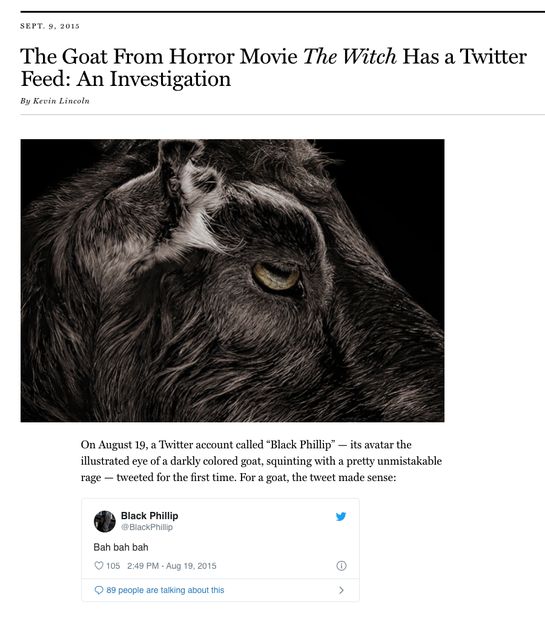How to Build Brand Recall in a Clickless World
Brand awareness is dwindling in organic search. Here's your strategy for building brand equity and recall by leveraging brand awareness. Learn more here.
Read More
There are very few industries that are as reliant on brand awareness strategy as the film industry. The cyclical nature of the business creates a constant necessity for the reach and engagement of new ticket buyers. This is something that film studios, big and small, all have to contend with; however, the deck is stacked against smaller, less resource-rich competitors.
Smaller production companies and studios don’t have the resources to compete dollar for dollar with bigger studios, like Warner Brothers and Paramount. For example, Paramount’s US marketing budget for Transformers: Age of Extinction was north of $100 million. That's more than the entire production cost of nearly every movie produced by the independent film company, Blumhouse Productions. That means that it only cost $3-5 million to make Academy-award winning movies, such as Whiplash and Get Out. As founder and CEO, Jason Blumhouse puts it:
That amount is about what we are able to recoup on the movies if we don’t get a wide release. In a worst-case scenario, we break even. That budget is reverse-engineered to thinking that if the movie isn’t in wide release, at least we get our money back and can keep our doors open.
For direct-to-consumer (D2C) brands, this scenario and risk-averse approach can sound familiar. As a result, challenger brands, not just upstart film studios, have been forced to be creative when it comes to the development of their brand awareness strategies. There are a few shining examples of how certain production companies have found ways to break through.
A24, the independent film production and distribution company behind hits such as Spring Breakers, Ex Machina, Lady Bird, and the Academy Award winner for best picture, Moonlight, has made a massive dent in the industry by leveraging unconventional methods to promote their films. They've made light of scenes from some of their horror movies. For example, to promote the movie Midsommar, A24 created and sold a toy bear in a cage (for those who have seen Midsommar, this can be one part hilarious, one part disturbing — but mostly disturbing).
The film company also utilized out-of-the-box business tactics to secure the distribution rights of the movie Spring Breakers. In an unexpected move, A24 gifted producers of the film gun-shaped bongs with the movie's title engraved on them. No matter the circumstance, those at the helm always know their audience.
Let's explore one of their less notable successes and see how they incorporated unique tactics to breathe life into their brand awareness strategy.
The Witch, released in 2015, is a horror movie that hits all the usual suspenseful notes but explores the world of Satanic practices. Noted as a minor hit, the movie took in $40.5 million in the box office. Now, that may not seem like a lot when compared to big studio tentpole films, but considering that the estimated budget was roughly $3.5 million, it would be foolish to suggest that this was not a massive success from a return on investment (ROI) perspective.
The A24 team began their work in earnest, thirteen months before the film's scheduled theatrical release. They wasted no time kicking off the traditional promotional cycle via screenings at a variety of film festivals and releases of a series of theatrical trailers. However, it was their social strategy that drove a lot of low-cost brand awareness.
They created social profiles on Twitter (collecting 10,000 followers and shooting out over 200 tweets), Facebook (over 435,000 followers), Instagram (posting 62 times over the course of 10 weeks), and even Snapchat. What’s fascinating (or horrifying) is that they also created a Twitter account for a pet goat featured in the movie called Black Phillip. The cheeky tone of Black Phillip’s Twitter feed proved to be a big hit, raking in more followers than the movie’s main Twitter account (10,800 followers).
The innovative idea was a hit with online publications like Vulture doing write-ups about Black Phillip's social presence. The tweets stood out because they were from Black Philip's POV and mirrored the internet's subversive meme culture. The pairing made for a hilarious, engaging (and again, disturbing) content.
Image: Vulture
But the most inventive and gutsy bit of marketing associated with this movie comes from A24's foray into co-marketing. They partnered with the Satanic Temple (yup, that's not a typo) to launch a now-defunct website called the Satanic Revolution. The thought was that an endorsement from them would imply that the movie was terrifying. This marketing stunt also caught the attention of other publications and nearly caused Poland to ban the director, Robert Eggers, from the country.
The key learning from The Witch's marketing campaign is that even though a brand may only have traditional distribution channels, it doesn't mean their efforts on those channels can be unique. A24 found a way to create more attention for the film by leveraging potentially controversial methods that somehow didn't feel forced because they aligned thematically.
Are you interested in developing your own out-of-the-box brand awareness strategy? Check out the blog post, What My High School Experiences Taught Me About Brand Awareness, to learn more.
Last updated on December 3rd, 2025.
